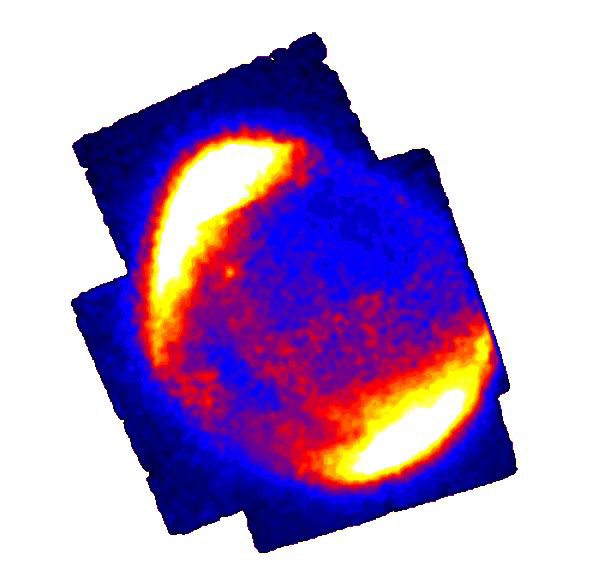
Acceleration

When particles are accelerated by a shock, as in solar events, they are knocked back and forth across the shock by the energy waves it generates. The particles gain energy and scatter more on each trip across the shock. The number of particles and strength of the waves decrease as they travel further away from the shock, to a point where there are not enough particles to produce strong waves. The particles then flow away from the shock.
This false color composite picture of the bright supernova remnant SN1006 (so named because it was first seen in the year 1006) was taken by the ASCA satellite. The expanding gas from the star collided into the surrounding material. The collision generated a violent shock, which produced x-ray light. The bright regions in the picture show the locations of this shock along the rim of the remnant. The energy spectrum produced in SN1006 provides the first clear link between particle acceleration at supernova shock fronts and high-energy cosmic rays. Image courtesy of Drs. R. Petre and E. Gotthelf, NASA GSFC.
 Acceleration in the News
Acceleration in the News
November 29, 2011: Earth's bow shock is remarkably thin -- Astrobiology
November 16, 2011: Cosmic particle accelerators get things going -- ESA
April 4, 2011: New type of particle accelerator beams its way to a world first -- Science Daily
March 24, 2011: Earthquake shakes Japanese science -- Astrobiology
February 1, 2011: Cluster encounters a natural particle accelerator -- ESA
January 17, 2011: Go jets -- HEAPOW
November 8, 2010: CERN completes transition to lead-ion running at the LHC -- CERN
May 3, 2010: Shortage of accelerator physicists getting worse -- Symmetry
April 20, 2010: Lightning creates particle accelerators above Earth -- National Geographic
April 19, 2010: Physicists find a particle accelerator in the sky -- Physics World
April 12, 2010: Cluster spacecraft take first look at acceleration processes driving aurorae -- Astronomy
April 5, 2010: Boosting the background -- HEAPOW
March 30, 2010: LHC research programme gets underway -- CERN
March 30, 2010: For one tiny instant, physicists may have broken a law of nature -- Science Daily
March 18, 2010: Fermi catalogs the gamma-ray sky -- APOD
March 7, 2010: Proton collisions detected at unprecedented levels of energy -- Science Daily
March 2, 2010: NASA's Fermi probes "dragons" of the gamma-ray sky -- NASA
March 1, 2010: Dark matter could meet its nemesis on Earth -- New Scientist
February 18, 2010: Fermi pins down a colossal accelerator -- Physics World
February 12, 2010: Scientists explore the future of high-energy physics -- Science Daily
November 30, 2009: LHC sets new world record -- CERN
November 23, 2009: Two circulating beams bring first collisions in the LHC -- CERN
November 20, 2009: The LHC is back -- CERN
October 26, 2009: MESSENGER gets closest-ever look at solar-flare neutrons -- Astronomy.com
October 2, 2009: Heart of a galaxy emits gamma rays -- Max Planck Society
September 16, 2009: CERN boss targets linear collider -- Physics World
September 9, 2009: Black holes are the ultimate particle smashers -- New Scientist
August 10, 2009: Particles as tracers for the most massive explosions in the Milky Way -- University of Gothenburg
July 8, 2009: Thunderclouds accelerate cosmic electrons -- Physics World
June 30, 2009: Thunderhead accelerator -- Physical Review Focus
June 25, 2009: Supernovae: Cosmic-ray superfactories -- Sky & Telescope
June 23, 2009: Iron-ic twist deepens cosmic ray puzzle -- Science News
January 6, 2009: Cassiopeia A comes alive across time and space -- NASA's Chandra mission
January 5, 2009: Desktop atom smashers could replace LHC -- New Scientist
January 2, 2009: European first as ALICE achieves energy recovery at 11 million volts -- Science Daily
December 31, 2008: Top ten physics stories of the year -- includes the Large Hadron Collider, quarks, and GCRs -- American Institute of Physics (AIP)
December 27, 2008: Crab pulsar wind nebula -- APOD
December 12, 2008: Michigan State will host rare isotope facility -- Physics World
December 3, 2008: Speaker sees new collider as a cooperative effort to solve nature's mysteries -- AAAS
October 13, 2008: Brookhaven Lab's Satoshi Ozaki awarded the Rober R. Wilson Prize -- Brookhaven National Laboratory
October 10, 2008: The day the world didn't end -- Science@NASA
September 25, 2008: Powerful nearby supernova caught by web -- NASA
September 15, 2008: SN 1006: A supernova ribbon from Hubble -- APOD
August 29, 2008: Integral locates origin of high-energy emission from Crab Nebula -- ESA
July 11, 2008: The Far 3kpc Arm -- APOD
June 13, 2008: At last, GLAST -- APOD
May 9, 2008: Colliding with nature's best-kept secrets -- CNN
April 3, 2008: South of Orion -- APOD
March 6, 2008: Vela Supernova Remnant -- APOD
February 25, 2008: Transformer -- HEAPOW
February 20, 2008: Integral: Stellar winds colliding at our cosmic doorstep -- ESA
February 8, 2008: NASA calls for suggestions to rename future telescope mission -- NASA GSFC
January 30, 2008: Galaxy distortions shed light on cosmic acceleration -- Physics World
Januray 27, 2008: Giant particle accelerator discovered in the sky -- Science Daily
January 10, 2008: Active galaxy Centaurus A -- APOD
November 28, 2007: UNH scientists report first findings on key astrophysics problem -- Eurekalert
September 2, 2003: Antimatter factory on Sun yields clues to solar explosions -- NASA GSFC
September 2, 2003: RHESSI satellite offers clues about how solar explosions act as particle accelerators -- UC Berkeley News
November 18, 2002: First 3-D magnetic reconnection measurements -- SpaceDaily
November 12, 2002: Satellite finds electrons brought to near-light speed -- Spaceflight Now
November 7, 2002: UC Berkeley analysis of satellite data turns up first direct evidence that magnetic processes in space can accelerate electrons to near light speed -- UC Berkeley






Questions and comments to: cosmicopia@cosmicra.gsfc.nasa.gov
Curator: Dr Eric R. Christian, NASA
Responsible NASA Official: Dr Eric R. Christian
Privacy Policy and Important Notices

HOME
In the News
History
Ask Us
Great Links
Glossary
Site Map
Search NASA